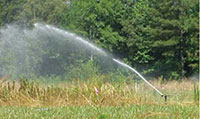Large-bore traveling gun and center pivot irrigation systems have been used to apply treated lagoon water, liquid animal manure, and untreated slurry from swine and dairy farms in many parts of the United States. The primary advantages of using irrigation equipment to spread manure on cropland are the lower costs for energy and labor and the higher speed of application as compared to using a tractor-drawn spreader. The primary disadvantages are related to greater odor release and the possibility of spraying manure on roads or another person’s property.
The loss of nitrogen
The amount of nitrogen lost to the air as ammonia from application of manure is important for two reasons. From the farmer’s point of view, the loss of nitrogen as ammonia gas represents fertilizer that could have contributed to the production of a crop.
From an environmental point of view, ammonia lost from a field to the atmosphere is a source of air pollution that can combine with sulfates and nitrates to form extremely fine particulate matter that can have harmful effects on human health. This particulate matter can also contribute to water pollution when deposited into surface water by rainfall.

Consequently, some government agencies have discouraged irrigation as a means to fertilize cropland with manure or have prohibited it completely due to concerns over an increase in ammonia emissions. Such regulations have a significant negative impact on dairy and swine producers who have invested in high levels of manure treatment that result in large volumes of dilute, liquid manure with low concentrations of nitrogen, phosphorous, solids, and minimal odor potential. Pumping diluted liquid manure through pipes to irrigation equipment is typically the most cost-effective means to use the water and nutrients to grow crops.
A closer look
A meta-analysis of 55 data sets from three independent sources was performed to quantify the ammonia-N lost during the interval of time from when the liquid manure exited the irrigation equipment and when a sample was collected on the ground. The study included data for irrigation of untreated liquid and slurry manure, surface water from treatment lagoons, and very dilute effluent from an oxidation ditch that was used to provide advanced treatment for cattle manure. The data set also included three types of irrigation equipment: a traveling big gun, large-bore solid set sprinklers, and center-pivot irrigation.
The data included measurements of the total solids content (TS, %), the total nitrogen content (TKN), and the total ammoniacal nitrogen content (TAN). The total ammoniacal nitrogen is the sum of the ammonium nitrogen, which is a good source of fertilizer, and the ammonia nitrogen, which is the part that can be lost to the air as a gas. Fortunately, most liquid animal manure has a pH near 8, and only 8% to 10% of the TAN is ammonia nitrogen.
In each of the studies, samples were collected from the manure that was irrigated onto a field, and samples were collected in containers placed in the field to catch the manure on the ground. The differences in these concentrations were analyzed to determine if the TS, TKN, or TAN had changed significantly as the result of irrigation alone.
The first step was to determine if any water evaporated during irrigation by analysis of the TS data. Well-known data, used in irrigation design, indicates that evaporation loss during irrigation ranges from 1% to 3.5%. It was determined that evaporation losses for all 55 data sets was small and averaged 2.4%, which agreed with expectations for irrigation.
Consider the impacts
The same type of analysis was done for the total nitrogen data. Total nitrogen includes the organic nitrogen and TAN. The results indicated that irrigation did not significantly alter the concentration of TKN. On the average, the TKN content of the ground-collected samples was slightly higher than the irrigated samples, which was obviously impossible.
The plot of the TAN concentrations collected on the ground and the TAN contained in the irrigated water is shown in Figure 1. The results showed that irrigation of manure did not result in a change in the concentration of TAN. On the average, the TAN concentrations in the irrigated and ground-collected manure differed by only 0.01%. Therefore, no ammonia nitrogen was lost from the manure during irrigation.

The results of this study do not imply that ammonia volatilization after manure strikes the ground is to be ignored. The suitability of irrigation as a liquid manure application method should be evaluated based on the level of treatment and the potential impact of odors on neighbors. Also, the irrigation system should be designed and operated so as to prevent overspray onto roads, property owned by neighbors, and any type of surface water. In addition, irrigation of liquid manure must be delayed if runoff begins.
Application methods that reduce ammonia loss and odor, such as band application, direct injection, or similar nitrogen conserving methods, are recommended if untreated slurry manure or lagoon sludge is to be used as a natural fertilizer substitute.
Reference: Chastain, J.P. 2019. Ammonia Volatilization Losses during Irrigation of Liquid Animal Manure. Sustainability 11(21), 6168; https://doi.org/10.3390/su11216168.
This article appeared in the November 2022 issue of Journal of Nutrient Management on pages 10-11. Not a subscriber? Click to get the print magazine.




